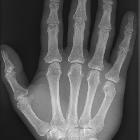Boxers fracture



























Boxer fractures are minimally comminuted, transverse fractures of the 5metacarpal neck, and are the most common type of metacarpal fracture.
A boxer's knuckle is a separate entity, which is a tear of the metacarpophalangeal joint sagittal band that causes subluxation of the associated extensor tendon.
Pathology
Mechanism
Boxer fractures are an impaction injury that almost always is a consequence of a direct blow with a clenched fist against a solid surface which causes axial loading of the 5metacarpal. Typical solid surfaces are walls or human faces, with young adult males by far the most commonly affected group (~95%) .
In most cases, the neck fracture is typically transversely-oriented and minimally impacted with volar angulated. Spiral fractures or angulation in other directions are also sometimes encountered.
Radiographic features
Plain radiographs are in almost all cases the only imaging required.
Plain radiography
Typically the fracture appears in the transverse plane through the metacarpal neck, with volar angulation of the distal fragment. Spiral fractures, which are less common, can be harder to visualize .
Features which should be commented upon include:
- morphology of the fracture: transverse, spiral, comminuted, oblique, etc.
- intra-articular extension, and degree of articular step-off
- degree of impaction/shortening
- degree of angulation
- degree of rotation: angulation on AP film implies a degree of rotation
- soft tissue gas which should be treated as suspicious for an open injury
The degree of palmar angulation is best assessed on the lateral radiograph, with lines drawn through the medullary canal. Lines may also be drawn along the dorsal cortex to assess palmar angulation . When this is not possible the oblique view can be used, however, this results in less accurate measurements that tend to overestimate the degree of angulation .
Report checklist
In addition to stating that a fifth metacarpal fracture is present, a number of features should be evaluated and commented up:
- fracture
- location, especially distance along the shaft
- comminution
- involvement of the articular surface of the MCP joint
- degree of angulation
- presence of rotation: this is critical! (see below)
- assess for any associated fractures and/or dislocations
- assess for any soft tissue gas
Treatment and prognosis
Although it can be treated conservatively, it is relatively unstable, and K-wire fixation is often required for better cosmetic results.
Closed reduction can be achieved by stabilizing the proximal part of the metacarpal dorsally and applying pressure to the head of the metacarpal from the palmar aspect while flexing the proximal phalanx . An ulnar nerve block may help .
A degree of residual palmar angulation is acceptable. The apex dorsal angulation for neck fractures should not exceed 30-40 degrees . When the fracture is of the shaft, less deformity is acceptable (less than 20 degrees). If angulation exceeds this, palmar pain and reduction of strength may be present on gripping .
No rotational deformity is acceptable as this can lead to significant disability, with the little finger overlapping other digits during flexion . Articular step-off in cases with intra-articular extension should be no more than 1-2 mm .
A short arm gutter-splint is applied, with flexion of the metacarpophalangeal joint, typically for 2-3 weeks followed by buddy-strapping . Prolonged immobilization can lead to stiffness.
Fractures of the fourth metacarpal neck can be treated in a similar fashion, whereas the second and third metacarpals usually require internal fixation .
History and etymology
Boxer fractures are named after the common mechanism of injury, namely that of throwing a punch. It should be noted that only a poorly thrown punch results in this type of fracture, and such injuries are actually uncommon in professional boxers who are taught to transfer as much power as possible through the second and third metacarpals .
See also
Siehe auch:
und weiter:

 Assoziationen und Differentialdiagnosen zu subkapitale Fraktur Os metacarpale 5:
Assoziationen und Differentialdiagnosen zu subkapitale Fraktur Os metacarpale 5:
